|
This extraction took about 9 hours of work, in two sessions,
and covered a time-span of four days. |
|
| Bees, who (like the Boll Weevil) are just looking for a home,
sometimes end up in those great condos that people are kind
enough to provide for them. Usually, this is a minor problem
but, when one is trying to SELL the house in question, it
escalates. |
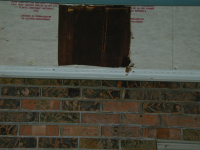 |
It is amazing how many potential buyers will refuse to even get out of the car when they see bees flying out from under the siding! |
|
These are some notes about my extracting a fairly healthy swarm from the structure of the house. In my initial conversation with the homeowner, it was described to me as a split-level rancher, with masonry up to about 3' above the ground, then, standard, stick-built construction the rest of the way up. Of course, on Friday, when I arrived at the site, I found that the house was built on a fairly steep hillside, and bees were coming out from under the siding at about the highest point above the driveway that they could find. It was only about 10 feet up, but, I had only brought the 6 foot ladder with me...so the first day's work promised to be exciting!
|
| At first I thought that the bees had gotten up into the wall cavity. However, when I examined inside the house, I could not hear any of the buzzing I would have expected. So....I moved on to peel off the vinyl siding and expose the original structure of the house. |
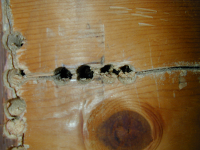 |
After removing some of the the original siding, and drilling a number of access holes in the rim joist, it appeared that the bees might have gone into the ceiling in the finished basement behind the rim joist. I could look through the holes I drilled through the rim joist, and, could see the girls moving around in the cavity behind. |
| Imagine my surprise when I set up in the finished basement area; cut a hole in the drywall ceiling and found....NOTHING. No sign of bees, no noise, no nothing. However, I did discover another 2x12 rim joist, sitting rather further into the house structure than I would have expected. A few measurements confirmed my suspicions that that the original owner of the house, who built it for himself in the 70s, apparently put two, 2x12 rim joists, placed about 18" apart and parallel to each other, to support the walls and floor structure above. This is, to put it mildly, unusual. |
| However, as it turned out, this odd construction promised to make the extraction a bit easier. I had been reluctant to cut too deeply into the outer rim joist, because of concerns about compromising the structural integrity of the wall. Since there were two support beams, I had fewer concerns about the slight weakening of the structure that would happen if I were to cut out out a section of this outer joist. |
| By the time I got to this point, though, I had to shut down for the day. Not only had I realized I would need a few more tools than I had, but, it was getting on towards Midnight, and, the homeowner was less that enthusiastic about hanging around. I had hoped to make it back to the swarm site on Saturday, but, a combination of circumstances delayed me until late Monday afternoon. |
| As I was driving back home from the swarm site, I meditated on the situation and mulled over the information I had gathered in my exploration of the structure. I came to the conclusion that there was a good chance that the bees might have built comb down into the cement block walls of the foundation. To get any of those insects out I would really need to use a bee vacuum. I did not have one at hand, though, and, it took the weekend to get access to one. I had planned to borrow a bee-vac, but, when that did not work out, I moved on to build a collection box to use with the vacuum I had. Finally, on Monday, I was able to get up to the swarm site, arriving at about 20:00. |
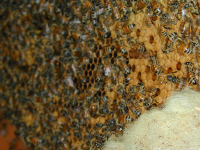 |
Since I had a clearer picture of the structure of the house and the location of the swarm, I put the tall ladder in place, and proceeded to saw out about a 12" section of the outer rim joist. I was surprised and pleased to find that the swarm had simply occupied a single cavity between the two joists. There were cross pieces stabilizing the joists and spaced about 18" or so apart, and the bees were contained in this (roughly) brood chamber sized space. They had not , as far as I could tell, gotten down into the foundation, as there were planks over it and some insulation. However, the cavity was quite full of comb and bees. |
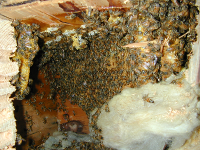 |
|
| They did require a bit of smoking but, in general, were quite laid back and took being removed from the cavity on comb and laced into a travel chamber without too much annoyance. There was a lot of brood in the comb, and, as far as I could tell, I was able to get the queen. I assume this because the bees that I carried down to the hive body stayed there, and did not return to the cavity. |
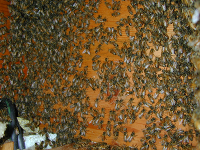 |
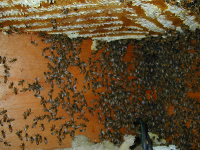 |
When I had gotten the vast majority of the bees extracted from the structure, and, into the brood box, I sprayed down the cavity with a bleachy cleaner, to kill the odor of bee and honey, and, sprayed some "great stuff" foam into the cracks to seal it up and (hopefully) keep another swarm from taking up residence. By the time I finished up and was able to roll back to Blaine, it was, again, close to midnight. I left the bees in the apiary, and, although they have quite a bit of honey in the comb with the brood, I probably will have to feed them for a bit, to help them recover from the stress of being moved.
|
|
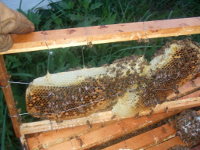 |
Here are a couple of shots of the comb I retrieved from the house, all wired into capture frames. The girls have been in there a couple of days, and, are working to fill in the missing parts with some enthusiasm. |
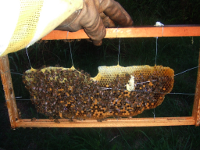 |
| As I suspected, they were pretty hungry, as there is not that much blooming around the area just now. So...I cooked up a batch of bee candy, and, popped a couple of four and a half in squares into the hive, sitting on top of the frames. They did take right to it,as you can see in this picture |
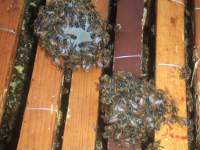 |
|
|
It has been rather hot and humid for the past few days, and, the girls have been doing what they can to ventilate the hive. here is a picture of the air conditioning crew. |
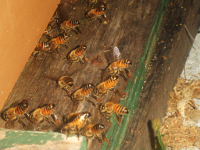 |









